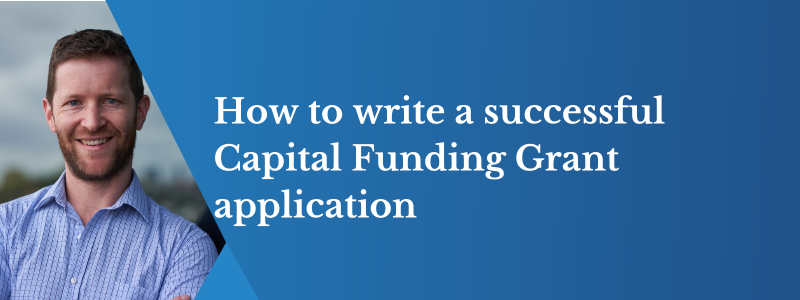3 tips for writing a successful Capital Funding Grant application
July 5, 2024 | Aged Care Management

By Stephen Rowan, Senior Manager
Applications for Capital Grants are OPEN NOW!
Securing Capital Assistance Grants is important for Australian aged care facilities looking to enhance their services, expand their infrastructure, attract staff, or improve the quality of facilities for their residents. However, the competition for these grants is fierce, and writing a successful application can be challenging. To help you navigate this process, here are three fundamental tips based on our experience in writing successful applications that can increase your chances of success.
1. Understand the funding criteria and guidelines
The first step in writing a successful grant application is to thoroughly understand the funding criteria and guidelines. The Department of Health and Aged Care has specific requirements, and tailoring your application to meet these can significantly enhance your chances of success.
- Start by researching the objectives and priorities set out for the grant. This will help you align your project with their goals. For example, if the grant application emphasises innovation in aged care, ensure that your application highlights how your project introduces new and effective methods of care.
- Read the guidelines carefully. Grant guidelines contain crucial information about eligibility, funding limits, application deadlines, and required documentation. Pay close attention to these details to ensure your application is complete and submitted on time. Missing even a single document or failing to meet a deadline can result in immediate disqualification.
- Ask questions. If you have any doubts or need clarification about the guidelines, don’t hesitate to contact the grant provider.
2. Present a compelling case for support
To stand out from the competition, and there will be plenty of it, your application must present a compelling case for why your project deserves funding. This involves clearly articulating the need for your project, outlining its impact, and demonstrating your capability to successfully implement it.
- Define the problem. Begin by defining the specific problem or need your project addresses. Use data and statistics to illustrate the scope and severity of the issue. For example, if your project aims to improve dementia care, provide evidence of the growing number of residents with dementia and the challenges they face in your facility.
- Describe your project. Clearly describe your project, including its objectives, activities, and expected outcomes. Be specific about what you plan to achieve and how you will do it. A well-defined project plan that includes timelines and milestones will give the grant provider confidence in your ability to deliver results.
- Highlight the impact. Emphasise the positive impact your project will have on residents, staff, and the wider community. Use qualitative and quantitative evidence to show how the project will improve quality of care, enhance the facility’s capacity, or contribute to the overall well-being of aged care residents. Testimonials, case studies, and pilot project results can be particularly persuasive.
- Demonstrate capacity. Grant providers want to ensure their funds are used effectively. Demonstrate your organisation’s capacity to manage the project by outlining your team’s qualifications, experience, and past successes. Include a detailed budget that shows you have carefully planned the project’s finances and can account for every dollar spent.
3. Ensure Clarity, Conciseness, and Professionalism
A well-written application is clear, concise, and professional. It should be easy to read and free of jargon, ensuring that the grant reviewers can quickly grasp your key points.
- Be clear and concise. Avoid long-winded explanations and get straight to the point. Use bullet points, headings, and subheadings to break up text and make it easier to read. Each section of your application should have a clear purpose and contribute to building a strong case for support.
- Use plain language. While it’s important to be detailed, avoid using technical jargon or complex language that might confuse reviewers. Write in plain language and explain any necessary technical terms as necessary.
- Proofread and edit. Errors and inconsistencies can undermine your application’s credibility. Carefully proofread your document to correct any spelling, grammar, or formatting mistakes. It can be helpful to have someone else review your application to catch errors you might have missed and provide feedback on its clarity and impact.
- Professional presentation. Present your application in a professional format. Use a clean, easy-to-read font and adhere to any formatting guidelines provided by the grant provider. Include a cover letter that succinctly introduces your project and expresses your organisation’s enthusiasm and commitment.
Writing a successful capital funding grant application facility requires a strategic approach, clear communication, and thorough preparation. By understanding the funding criteria, presenting a compelling case for support, and ensuring clarity and professionalism, you can significantly enhance your chances of securing the funds needed to improve your facility and the lives of your residents. Remember, a well-crafted application not only demonstrates your project’s value but also reflects your organisation’s dedication to providing high-quality aged care.
How we can help you with your application
We have an experienced team who have created success for clients in obtaining grant funding. You can read a case study here on the success we had for a client in the last funding round.
To get your application started, reach out early, as the deadline for submissions is 29 August 2024.


